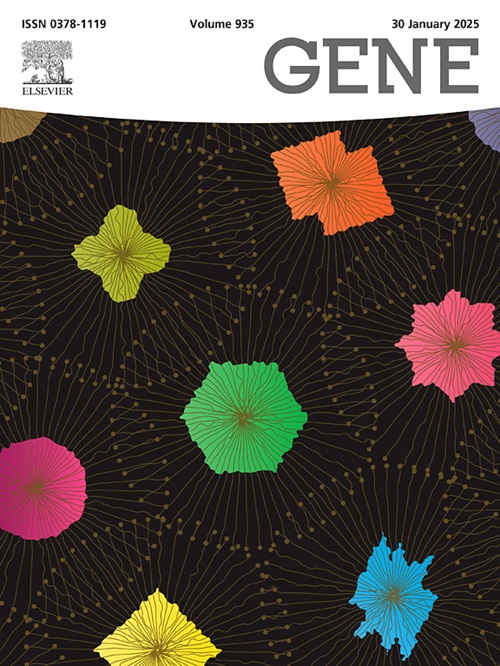Association of intronic variants (Apal and Bsml) of vitamin D receptor gene with uterine leiomyoma among North Indian women
IF 2.6
3区 生物学
Q2 GENETICS & HEREDITY
引用次数: 0
Abstract
Background
Understanding the genetic factors involved in the Uterine Leiomyoma (UL) development is crucial for exploring the complexities of UL disorders. This study aimed to examine genetic association between UL incidence and intronic polymorphisms of vitamin D receptor gene in north Indian population.
Methodology
Total 200 subjects (100 healthy women and 100 with uterine leiomyomas) of age- and gender-matched control subjects, were genotyped for BsmI (rs1544410) and ApaI (rs7975232) polymorphisms in the VDR gene using TETRA ARMS PCR, followed by Sanger sequencing validation. Levels of VDR mRNA and vitamin D were also assessed through quantitative real-time PCR and ELISA respectively. The association of these variants with leiomyomas was analyzed, along with clinico-pathological (obesity) association.
Results
ApaI revealed a significant association with UL, especially for the TG genotype (OR = 2.38; 95 % CI, 1.26–––4.51; p = 0.003). In a similar manner, ApaI is associated with an increased risk for UL with all three genetic models. Comparing VDR ApaI polymorphism between obese and non-obese patients revealed that AC genotype was significantly (OR = 3.71; 95 % CI, 1.53––9.11; p = 0.002) associated with a reduced risk of UL in non-obese patients. The expression of VDR mRNA was two times lower in patients with UL (p < 0.001), along with decreased serum vitamin D levels (p < 0.001). A significant association was also observed between VDR ApaI variant with reduced mRNA expression, vitamin D level and obesity. However, no associations were observed among Bsm1 VDR genotypes and ULs.
Conclusion
This study found significant association between the VDR intronic ApaI polymorphism (rs7975232) and the incidence of UL. This VDR variant showed significant association with reduced VDR mRNA expression and serum vitamin D levels in UL patients. However, no significant association was observed between BsmI VDR polymorphism (rs1544410) and UL in North Indian women.
北印度妇女维生素D受体基因内含子变异(Apal和Bsml)与子宫平滑肌瘤的关系
背景了解子宫平滑肌瘤(UL)发生发展的遗传因素对于探索子宫平滑肌瘤疾病的复杂性至关重要。本研究旨在研究印度北部人群UL发病率与维生素D受体基因内含子多态性之间的遗传关系。方法采用TETRA ARMS PCR方法对200例年龄和性别匹配的对照组(健康女性100例和子宫平滑肌瘤患者100例)进行BsmI (rs1544410)和ApaI (rs7975232) VDR基因多态性分型,并进行Sanger测序验证。通过实时荧光定量PCR和酶联免疫吸附测定VDR mRNA和维生素D水平。分析了这些变异与平滑肌瘤的关系,以及与临床病理(肥胖)的关系。结果apai与UL有显著相关性,尤其是TG基因型(OR = 2.38;95% ci, 1.26—4.51;p = 0.003)。以类似的方式,在所有三种遗传模型中,ApaI与UL风险增加相关。比较肥胖与非肥胖患者的VDR ApaI多态性,AC基因型差异有统计学意义(OR = 3.71;95% ci, 1.53—9.11;p = 0.002)与非肥胖患者UL风险降低相关。UL患者的VDR mRNA表达降低2倍(p <;0.001),同时血清维生素D水平降低(p <;0.001)。VDR ApaI变异与mRNA表达降低、维生素D水平和肥胖之间也存在显著相关性。然而,Bsm1 VDR基因型与ULs之间没有关联。结论本研究发现VDR内含子ApaI多态性(rs7975232)与UL发病率有显著相关性。该VDR变异与UL患者VDR mRNA表达降低和血清维生素D水平显著相关。然而,在北印度妇女中,未观察到BsmI VDR多态性(rs1544410)与UL之间的显著关联。
本文章由计算机程序翻译,如有差异,请以英文原文为准。
求助全文
约1分钟内获得全文
求助全文
来源期刊

Gene
生物-遗传学
CiteScore
6.10
自引率
2.90%
发文量
718
审稿时长
42 days
期刊介绍:
Gene publishes papers that focus on the regulation, expression, function and evolution of genes in all biological contexts, including all prokaryotic and eukaryotic organisms, as well as viruses.
 求助内容:
求助内容: 应助结果提醒方式:
应助结果提醒方式:


